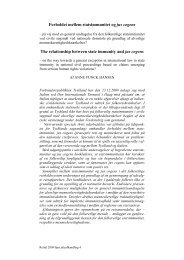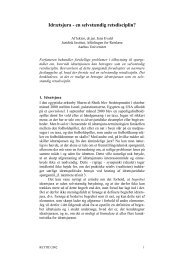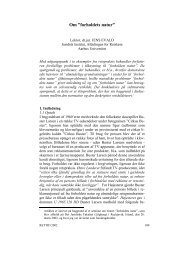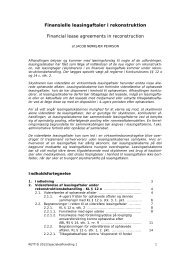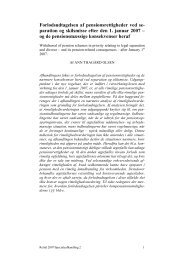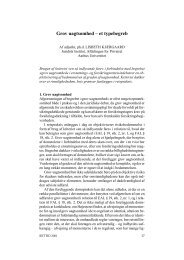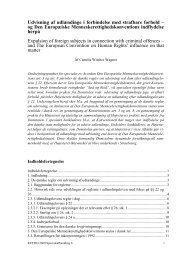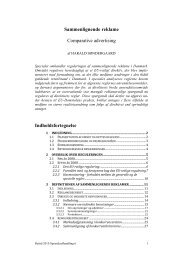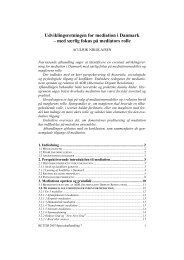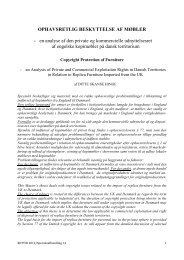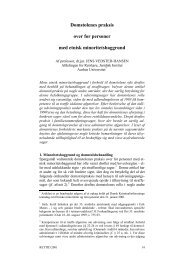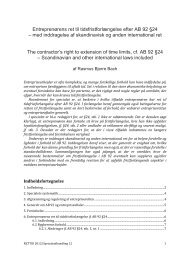Product liability under the CISG and Concurring tort law claims ...
Product liability under the CISG and Concurring tort law claims ...
Product liability under the CISG and Concurring tort law claims ...
Create successful ePaper yourself
Turn your PDF publications into a flip-book with our unique Google optimized e-Paper software.
Allowing concurrent domestic remedies would have <strong>the</strong> consequence that <strong>the</strong> seller´s <strong>liability</strong> would vary<br />
depending on which domestic <strong>law</strong> was applicable pursuant to <strong>the</strong> private international <strong>law</strong> rules. This<br />
would jeopardize uniform application of <strong>the</strong> Convention, <strong>the</strong> success of which must be categorized as one<br />
of <strong>the</strong> most important aims of <strong>the</strong> Convention. 111<br />
The argument presented by Professor Lookofsky that if Courts in contracting states interpret <strong>the</strong> Convention<br />
remedies as non-exclusive in situations, where faced with <strong>the</strong> same facts, this will represent a uniform<br />
interpretation of <strong>the</strong> remedial rules in <strong>the</strong> Convention, even though domestic <strong>law</strong>s in <strong>the</strong> involved states<br />
may differ, 112 does not take into account <strong>the</strong> certainty aspect.<br />
The need to promote uniformity is inevitably linked with being able to provide international trade with<br />
some degree of certainty. If <strong>the</strong> Convention cannot provide this certainty, companies will opt out of <strong>the</strong><br />
Convention cf. art 6 <strong>CISG</strong> <strong>and</strong> <strong>the</strong> Convention will not have <strong>the</strong> success hoped for.<br />
If <strong>the</strong> Convention remedies are interpreted as non-exclusive, <strong>and</strong> in that sense interpreted uniformly, it still<br />
leaves international trade with <strong>the</strong> very difficult situation of predicting which st<strong>and</strong> a particular domestic<br />
court might take - whe<strong>the</strong>r to apply <strong>the</strong> Conventions remedies or domestic <strong>tort</strong> remedies - in an attempt to<br />
prepare for future events. Therefore, in this author´s opinion, <strong>the</strong> solution provided by Professor Lookofsky<br />
does not fulfill <strong>the</strong> important aim of providing certainty in <strong>the</strong> Convention.<br />
If you look up “uniform” in <strong>the</strong> dictionary, <strong>the</strong> definition is “<strong>the</strong> same in all parts <strong>and</strong> at all times” 113 <strong>and</strong> it is<br />
this form of uniformity, which is necessary for <strong>the</strong> Convention to achieve success as an instrument in international<br />
trade.<br />
Allowing concurring <strong>claims</strong> will result in <strong>the</strong> opposite of a uniform solution <strong>and</strong> could potentially jeopardize<br />
<strong>the</strong> success of <strong>the</strong> Convention. It will not only result in a circumvention of some of <strong>the</strong> provisions in <strong>the</strong><br />
Convention, but indeed circumvent <strong>the</strong> entire aim of <strong>the</strong> Convention as expressed in <strong>the</strong> Preamble. When<br />
finding a possible solution to <strong>the</strong> puzzle of concurring <strong>claims</strong> this is a very important consideration to bear<br />
in mind.<br />
4.4.2. <strong>Product</strong> <strong>liability</strong> <strong>law</strong>s<br />
Whereas contract <strong>law</strong> protects what a party is entitled to expect <strong>under</strong> a contract, <strong>tort</strong> <strong>law</strong> protects a wider<br />
<strong>and</strong> more fundamental range of interests, which exist independently from any contractual relationship. The<br />
general consideration <strong>under</strong>lying domestic product <strong>liability</strong> <strong>law</strong>s is based on <strong>the</strong> notion that buyers should<br />
be compensated, when dangerous or defective goods cause injury or damage to <strong>the</strong>m or <strong>the</strong>ir property.<br />
The considerations <strong>under</strong>lying product <strong>liability</strong> <strong>law</strong>s are in general similar. This section will be based on Danish<br />
product <strong>liability</strong> <strong>law</strong> but it is similar notions which will be circumvented on a global scale if <strong>the</strong> Convention<br />
is given a preemptive effect.<br />
There are two different systems of product <strong>liability</strong> in Denmark. Firstly act no. 261 of 20 th March 2007 concerning<br />
product <strong>liability</strong>, which is based on <strong>the</strong> EC <strong>Product</strong> Liability Directive of 25. July 1985, 114 <strong>and</strong> secondly<br />
a set of product <strong>liability</strong> rules developed in case <strong>law</strong>, which have not been codified. The two systems are<br />
very similar however <strong>the</strong>re is one important difference to note in this context. The product <strong>liability</strong> act governs<br />
only damage to consumer property cf. § 2 herein. Companies that wish to claim damages based on<br />
product <strong>liability</strong>, when defective goods have caused damage to <strong>the</strong>ir property, will have to do so via <strong>the</strong><br />
111 Huber in Schlechtriem/Thomas page 370 para 47 <strong>and</strong> Schwenzer/Hachem page 470 section 2.<br />
112 Lokoofsky, In dubio, page 288 <strong>and</strong> n 124.<br />
113 See Oxford Dictionary, section U, page 1673, <strong>the</strong> definition of <strong>the</strong> word “uniform”.<br />
114 EC Council Directive 85/374.<br />
RETTID 2012/Specialeafh<strong>and</strong>ling 26 28



